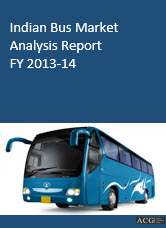The Indian Bus market is one of the most thriving sectors that is predicted to show tremendous change over the coming years. It is estimated that this market size is likely to double it's current size by the year 2020, owing to more than 80,000 units only in the >8t segment. Translating this fact into statistics shows that the category of buses above 8 tonnes will result in every fifth bus being sold worldwide will be geographically located in India. Though the future forecast seems promising, the year from 2012 to 2013 saw a negative 5 % growth which was quoted as the "first time that overall market is shrinking". That being said, the consumer has to battle the causes and effects of inflation. Though it has been difficult to put a finger on exactly how this inflation will pan out, it is agreed upon that a slower annual gain has indeed, in the long run helped to lift the load off the consumer.
A government report released here on Thursday showed an all-time low in the last three months amounting to an 8.28% in May in contrast to the 8.59% in the previous month. It predicted a couple other findings. According to the above said report, fuel prices would increase and the Budget deficit of GDP would decrease. Modi plans to construct more ports, roads and bridges in order to secure investment and it has been predicted that this move of his will definitely increase the GDP to an all-time high seen in the last four years of 6.5% in the duration of a year ending with the March of 2016. Additionally, the report also predicted that the IIP rate would increase and many steps were taken in order to increase the rate of manufacturing.
The following report details the recent out comings and trend analysis of the market. The new government has introduced a great deal of projects and broadcasted improved infrastructure plans. This plan has been extended to 100 developed cities. The growth rate is further calculated by plotting graphs to witness how change in the rate of emissions is affecting the sales. With the coming of new projects, what becomes mandatory is the need to increase demand and this arises out of expanding the borders of cities. One of the major standing causes for the flourishing of the Indian bus industry is the fact that the sky rocketing price of fuels is pushing consumers to shift to public transport means instead of private, which turns out to be a highly wallet-burning option. Additionally, schools, BPOs and corporates need buses to provide a comfortable transport option to t's dwellers which makes up for another reason for increased popularity of buses in India. Beyond all this, many people are moving into the Middle class who prefer public means of travel and not to mention, India's rising population, ensuring that an industry thrives it's maximum here.
Production:
The production figures see a two-company dictated process where Ashok Leyland and Tata Motors owe for more than three-fourths of total number of buses produced. The clear pioneers are Ashok Leyland and Tata Motors. However, one thing that’s notable is the decrease in sales from 2012-13 to 2013-14. Companies like VECV-Eicher and SML Isuzu also add to a minor percentage of the production numbers, though not much. Companies like Volvo uses, M&M and Scania on the other hand are virtually non-existent in terms of production figures.
Sales:
Linear to the production graphs, the sales figures paint a similar picture. Tata Motors and Ashok Leyland dictate the sales scenario also with VECV-Eicher, SML Isuzu and MTB accounting for a very minute percentage of the sales figures. Companies like Volvo buses, Scania and Mahindra & Mahindra are invisible in terms of sales numbers. Though Tata and Ashok Leyland have seen such a flourishing growth they have both seen an equally big downfall of about 10% in sales from 2012-13 to 2013-14.
Export:
The export kingdom has also been ruled by the two big superpowers: Ashok Leyland and Tata Motors. The other companies in the race are like tiny dots on an ocean: virtually invisible. Export has purely been dictated by these two companies.
Not surprisingly, Ashok Leyland stands at the top of the market flow chart with almost half the market share. This number has only slightly reduced in the subsequent year. Tata Motors on the other hand, being equally a superpower has seen a 1% increase in market share. VECVs-Eicher and SML Isuzu have managed to stay in the picture with a minority market share, however companies like Volvo, M&M and Scania have not achieved to even start this race.
Sales Market Share:
The domestic sales have also been reported graphically in the following analysis. It comes as no big surprise when Tata Motors and Ashok Leyland arrive at the top in this aspect too. The domestic sales share is shared equally by Tata Motors. Tata Motors' market share has shot up by 2% while Ashok Leyland's share has plummeted by the same amount in the period between 2012-13 to 2013-14.
Export Share:
The export market share has however single headedly been dictated by Ashok Leyland with as high as a 70% share in 2012-13. This figure however has reduced by 8% in the subsequent year. Tata Motors has seen a flourishing increase in export market share by 3% over the same period. Other companies however have been dormant in terms of export share.
LCV Sales:
The LCV segment has Tata Motors in the scene, but Ashok Leyland is nowhere to be found. Though Tata motors has seen a slight decrease in sales over the year from 2012-13 to 2013-14, it still stands as the pioneer of this group. Force Motors has also made it's stand in this sector with an equal share in sales as Tata Motors in the LCV segment. Minor but still existent sales can be seen in VECVs-Eicher, SML Isuzu and MTB.
Market Share:
The sales market shares in the LCV segment as translated by the sales figures has Tata Motors and Force Motors as the dictators of the segment with almost 40% sales share in both the companies. VECV-Eicher has seen a 2% increase to amount to a 10% sales share in 2013-14 from 2012-13. Similar situation is witnessed in the case of SML Isuzu and MTB.
Export: LCV
The LCV exports are not a very high industry, but what exists is dictated by Tata Motors whose figures however has reduced in the year from 2012-13 to 2013-14. The three companies owe to just a few units exported during the same period.
The market share in the exports sector of the LCV segment puts Tata Motors on a pedestal. The other companies as seen in the exports figures owe to insignificant values to export market share.
Medium Duty Bus
The MCV segment comprises of buses in the 7.5t to 12t section. Out of the six companies that dictate this segment, Tata Motors has seen the maximum sales in the time between 2012-13 to 2013-14. Ashok Leyland, SML Isuzu and VECVs-Eicher are close followers all oscillating between the 3000 units sold mark.
Market Share:
As seen in the sales figures graph, the sales market share translates the same analysis. Tata Motors has seen a stagnant market share owing to around 37% of the market in the MCV segment. Ashok Leyland, SML Isuzu and VECVs-Eicher also aid to a considerable market share whose numbers are almost equal. Ashok Leyland has seen a 2% increase in sales in the duration between 2012-13 to 2013-14.
The export figures for the period from 2012-13 to 2013-14 are exhibited thus. Ashok Leyland stands as the first in this aspect with the other companies not even coming close to it. VECVs-Eicher on the other hand saw its export figures multiplied four times in the mentioned period. Tata Motors has been racked by Eicher who currently stand as the runners up after Ashok Leyland.
The market share for Ashok Leyland has come down by almost 10% in the period between 2012-13 to 2013-14. VECVs-Eicher on the other hand has seen an increase in it's market share from a mere 9% to a stunning 27% in the same period. Tata Motors has also seen a 10% decrease in export market share standing at a 18% export market share presently.
Medium Duty Bus
The medium duty bus sales figures show Ashok Leyland who stand at the top, however suffering from a decrease in sales in the period between 2012-13 and 2013-14. Tata Motors also shares the position of leaders of this segment.
The sales share revolve at almost 50% sales market share each for Ashok Leyland and Tata Motors with VECVs-Eicher with an insignificant 4% market share at the end of 2013-14.
Export:
Export figures again shine a spotlight on two companies, namely, Ashok Leyland and Tata Motors. Ashok Leyland saw a 10% decrease in it's export figures over the year while Tata motors saw an equal increase to owe to about 1818 units exported.
Market Share:
The export figures are translated onto the export share with Ashok Leyland keeping a stand on nearly three-fourths of this segment and Tata Motors with almost one-fourth combining to be the super powers of this segment





